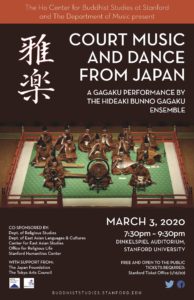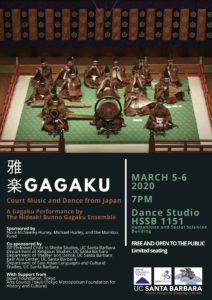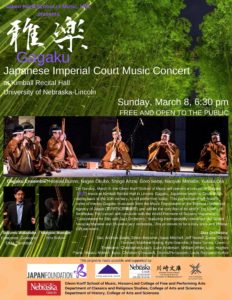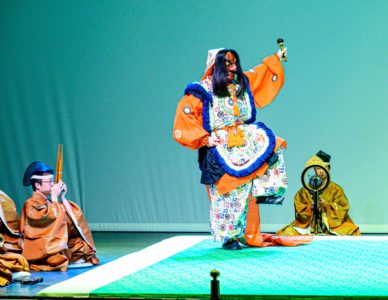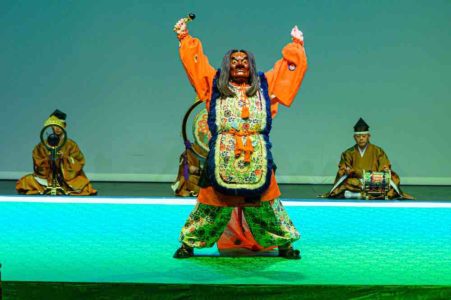Hideaki Bunno GAGAKU Ensemble
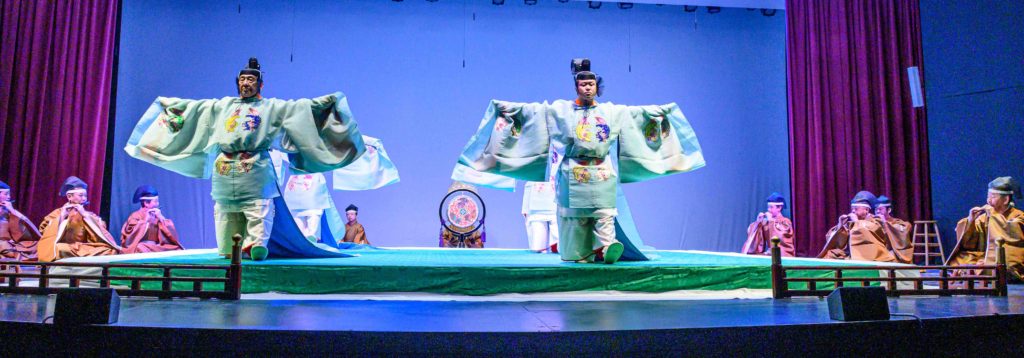
Produced by Naoyuki MANABE ,
the performance at Stanford includes pieces from all genres of the classical Gagaku repertory: representative pieces of instrumental music (kangen), vocal music (including ancient secret songs Kagura-uta performed at Shinto ceremonies at the imperial palace), and dance pieces (Bugaku).
This performance offers a unique glimpse in the fascinating world of Gagaku, the classical music and dance of the Imperial Court of Japan and an important component of Buddhist and Shinto liturgies. Internationally recognized as the most ancient living musical tradition in the world and as a cultural patrimony of humanity, this music is exceptional in its combination of an archaic allure with unexpected contemporary features (free rhythms, complex sound clusters, controlled dissonance).
With support from: The Japan Foundation and the Arts Council Tokyo
![]()
![]()
雅楽は1300年以上の歴史を持ち器楽、歌、舞からなり、世界最古のオーケストラとしてユネスコ世界遺産に登録されている。
カリフォルニア地域での演奏会にあたり、雅楽全体の演奏形態を網羅した、管絃・舞楽・歌物を含む本格的・多彩なプログラムを構成した。
それぞれの楽器の能力を発揮する、特徴的な曲に焦点を当て、演奏法、演奏様式も多様で変化のある曲目を選んだ。
これらを通して日本人の美意識・価値観を一同に紹介する事ができるであろう。
701年に制定された大宝律令に雅楽寮の記載がある。ここが雅楽の伝承の出発点とされているが、その歴史を現在も受け継ぐのが宮内庁式部職楽部である。その元首席楽長4人を中心メンバーとしたHideaki Bunno GAGAKU Ensembleはこれまでの雅楽会の枠を外し、日本全国の有能な演奏家を集め結成した。
聞きどころ
今回のプログラムの大きな聞きどころは退吹である。
雅楽の演奏様式で退吹(おめりぶき=旋律を少しずつずらし追いかけながら吹く奏法)と言うものがある。
真鍋尚之は長年に渡りこの退吹の演奏方法を研究してきた。
退吹の試み参照
《黄鐘調調子》では笙2管の退吹。
そして《胡飲酒》では二群に分かれた退吹による新しいスタイルでの上演を行う。「林邑乱序」での笛の退吹。「序」では二群に分かれた笙・篳篥・笛が退吹行い節目で全てがユニゾンになる序吹による演奏。
3.3.2020.
GAGAKU Court Music and Dance from Japan
(DINKELSPIEL AUDITORIUM, STANFORD UNIVERSITY)
3.5.2020.
Court Music and Dance from Japan
(UCSB Dance Studio)
3.6.2020.
Court Music and Dance from Japan
(UCSB Dance Studio)
3.8.2020.
GAGAKU Japanese Imperial Court Music Concert
(UNL Kimball Recital Hall)
3月3日 ワークショップ;スタンフォード大学
3月3日 演奏会;スタンフォード大学
3月5日 ワークショップ;カリフォルニア大学サンタバーバラ校
3月5日 演奏会;カリフォルニア大学サンタバーバラ校
3月6日 ワークショップ;カリフォルニア大学サンタバーバラ校
3月6日 演奏会;カリフォルニア大学サンタバーバラ校
3月8日 演奏会;ネブラスカ大学リンカーン校
Hideaki Bunno GAGAKU Ensemble
Shō;
BUNNO, Hideaki (U-Mai, San-no-Tsuzumi)・MANABE, Naoyuki (U-Mai, San-no-Tsuzumi, Wagon, Koto)・Wada・Atsushi (U-Mai)・ SHIBAGAKI, Haruki (U-Mai)・ NAGAI, Taishi (Shōko)
Hichiriki;ŌKUBO, Nagao (Taiko, Kakko)・ IKEBE, Gorō (Taiko, Kakko)・HONDA, Eshō・MIURA, Motonori (U-Mai, Koto), MATSUHISA, Takao (Sa-Mai)・ SOYAMA, Toshiyuki, OKADA, Shōhei (Shōko)
Fue(Ōteki, Komabue, Kagurabue);
ANZAI, Shōgo・ŌTA, Yutaka (Biwa)・ KATŌ, Michinobu (Biwa, Taiko)・ UMEDA, Masashi (Shōko)・IWASAKI Tatsuya
笙;
豊英秋(右舞・三ノ鼓)、真鍋尚之(右舞・三ノ鼓・和琴・箏)、和田篤志(右舞)、柴垣治樹(右舞)、永井大志(鉦鼓)
篳篥;
大窪永夫(鞨鼓・太鼓)、池邊五郎、本多惠昭(鞨鼓・太鼓)、三浦元則(右舞・箏)、松久貴郎(左舞)、岡田庄平(鉦鼓)、曽山俊之、
笛;
安齋省吾、太田豊(琵琶)、加藤道信(琵琶・太鼓)、梅田真史(鉦鼓)、岩崎達也、
Programm プログラム
舞楽《白濱》Hõhin
《黄鐘調調子》Ōshikichō-Chōshi
神楽歌(Kagurauta)より
《神楽音取》Kagura no Netori
《千歳》Senzai
《其駒》Sonokoma
管絃
《太食調音取》Taishikichõ no Netori
《合歓塩》Gakkaen
《傾盃楽》Keibairaku
《抜頭》Batõ
舞楽
《胡飲酒》Konjyu
-林邑乱序 Rinyū-ranjyō
-迦陵頻音取 Kryõbin-no-netori
-序 Jyo
-破 Ha
-重吹 Shigebuki
Stanford
3.3.2020.
GAGAKU Court Music and Dance from Japan
(DINKELSPIEL AUDITORIUM, STANFORD UNIVERSITY)
舞楽《白濱》Hõhin
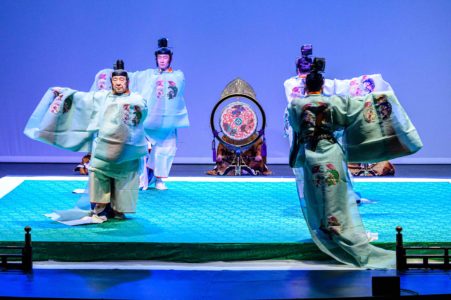
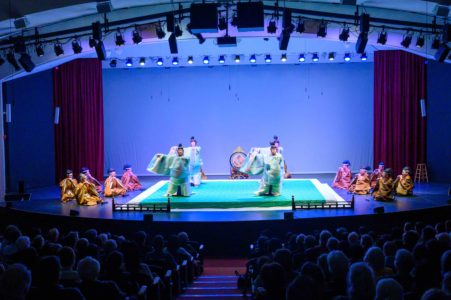
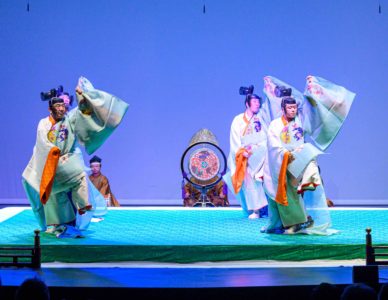
《黄鐘調調子》Ōshikichō-Chōshi
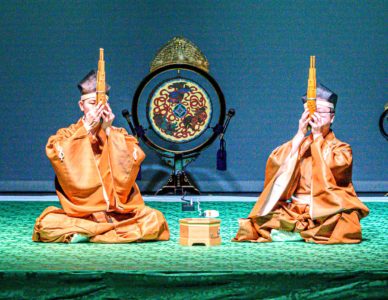
神楽歌(Kagurauta)より
《神楽音取》Kagura no Netori《千歳》Senzai《其駒》Sonokoma

管絃
《太食調音取》Taishikichõ no Netori《合歓塩》Gakkaen《傾盃楽》Keibairaku《抜頭》Batõ

舞楽
《胡飲酒》Konjyu
Photo Credit: Robert Most
Website; Stanford Uni.
雅楽カリフォルニア公演実行委員会
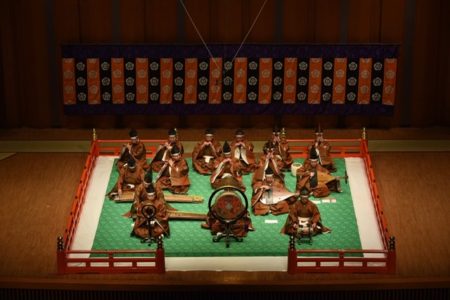
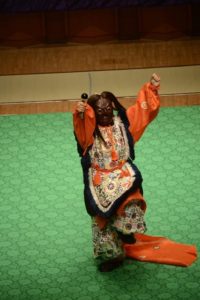
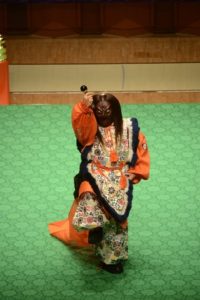
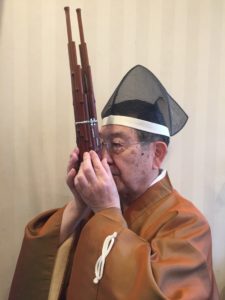
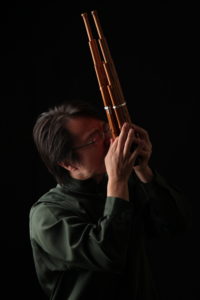
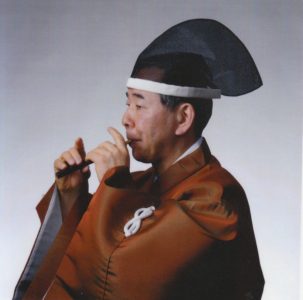
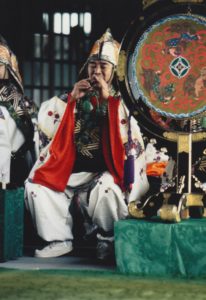
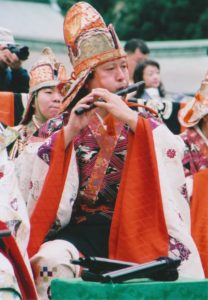
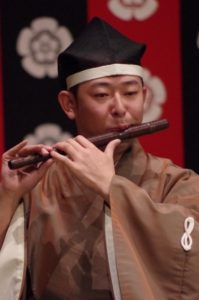
![]()
![]()
